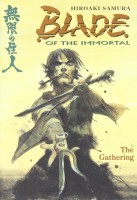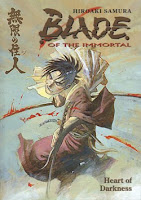 Creator: Hiroaki Samura
Creator: Hiroaki Samura
U.S. publisher: Dark Horse
ISBN: 9781569717462
Released: June 2002
Original release: 1999
Awards: Eisner Award, Japan Media Arts Award
Secrets is the tenth volume of Dark Horse’s English-language release of Hiroaki Samura’s manga series Blade of the Immortal. Published in 2002, it collects chapters forty-eight through fifty-four, making it nearly equivalent to the ninth volume of the Japanese edition which was first published in 1999. Blade of the Immortal is liked by both critics and more casual fans, among which I am happy to include myself. In 1997 the series won a Japan Media Arts Award. It was also the recipient of an Eisner award in 2000. At this point, Blade of the Immortal is well into its story; Secrets is the beginning of the third major plot arc in the series. The previous arc ended with The Gathering and The Gathering, Part II. To put it mildly, both volumes were fairly intense. I was looking forward to seeing how the characters would deal with the consequences of those volumes and where Samura would take the story next with Secrets.
Kagehisa Anotsu is the leader of the Ittō-ryū, a rogue sword school that is quickly gaining power and prestige in Edo. The school isn’t so concerned with style as it is with winning and so when its members fight anything goes. Anotsu has been invited to the Shingyōtō-ryū dōjō in the mountains of Kaga to discuss the school’s assimilation into the Ittō-ryū—an odd situation since most other sword schools have fallen to the Ittō-ryū by force. Anotsu has finally reached Kaga safely (the same can’t be said for his decoys back in Edo) but the students of the Shingyōtō-ryū are far from happy with his presence at their school. Elsewhere in Edo, Manji is recovering from his most recent encounter with the Ittō-ryū which literally left him in pieces. He may be nearly immortal, but even the kessen-chū that keep him alive have their limitations. Rin may have made it through the Edo checkpoint in her pursuit of Anotsu, but she is quickly discovering that traveling on her own without Manji is more challenging, and more dangerous, than she initially realized.
It has been several volumes since Anotsu has made an actual appearance in Blade of the Immortal. I find this particularly interesting because his very existence is the driving force behind so many of the other characters’ actions. Two different sides of his nature are seen in Secrets. It has already been established in the series that Anotsu is a skilled swordsman. Because it is a more formalized duel, his fight with Iriya, one of the top students of Shingyōtō-ryū, isn’t anywhere near as violent as Manji’s fight from the previous two volumes, but it’s still a very tense situation. Although Anotsu is surprised by Iriya’s skill—which proves just how good Iriya is—Anotsu remains calm and collected throughout the fight. The duel also reveals that the two sword schools’ philosophies aren’t that dissimilar. This and his discussion with the head of the dōjō give Anotsu plenty to think about. He may be a fighter, but he doesn’t rely on his sword alone. Anotsu is also politically ambitious, contemplative, and calculating.
Anotsu isn’t the only character to make a reappearance in Secrets. Master Sōri, a close friend of Rin’s now deceased father and a rather eccentric artist from early on in the series, also makes his return. He has a somewhat unexpected connection to the Mugai-ryū. He is able to share some very important information about the group of killers with whom Manji had so recently allied himself. I wasn’t really expecting Sōri to have a critical role in Blade of the Immortal so I’m curious to see just how big a part he will end up playing. He has certainly show himself to be necessary at this point in the story. Another character I was happy to see return was Magatsu, a former member of the Ittō-ryū. He and Manji have some unfinished business to attend to and it’s an excellent setup for the next volume in the series, Beasts. I’d say the third story arc in Blade of the Immortal is off to a great start.




